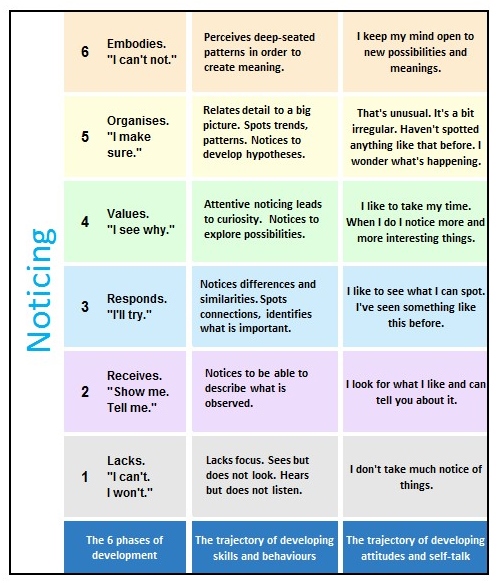Get a handle on progression
As with all learning behaviours, Noticing is not a case of ‘either you do, or you don’t’. Few learners are oblivious to detail in every circumstance, and equally few are hugely attentive to detail in every situation. Most lie somewhere between these 2 extremes.
The chart below offers a glimpse of how Noticing may grow. Column 1 identifies 6 phases of development, column 2 describes how the skills and behaviours may grow over time, column 3 shows the self-talk; what students may quietly say/explain to themselves at each phase of development.
What the phases mean
What the phases mean
The phases are drawn from Bloom’s taxonomy of the affective domain.
Phase 1 ‘Lacks’ (grey) where the behaviour is weak and the response is negative.
Phase 2 ‘Receives’ (purple) is about doing something because you are told or expected to.In self talk student may say ‘Show me or tell me”
Phase 3 ‘Responds’ (blue) is about gaining interest and doing things more willingly. This might translate to “I’ll try” in student self talk
Phase 4 ‘Values’ (green) is a key phase since the student now sees the value of behaving in this way. It’s a win for them; to behave like this is in their interest. It’s in this phase that the behaviour becomes more secure. In self talk this might translate into “I see why”
Phase 5 ‘Organises’ (yellow) is the phase in which the student capitalises on this ‘in their interest’ behaviour and gets themselves organised to use it positively. In student self talk this might translate into “I’ll make sure I do”.
Phase 6 ‘Embodies’ (orange), known as ‘characterised’ in the original taxonomy. In this phase the student has made this behaviour their own. It has become part of their character; they can’t not do it and they have become highly skilled in doing it. In student self talk this might translate into “I can’t not do”.
This progression as long term. Some phases will take years for people to work through; some will never be worked through. None of the phases are inevitable. There is a lifetime of development captured here. Nevertheless the role of a teacher or parent should surely be to encourage and enable this journey.
- Take time to think about a class you know well. Ignoring the ‘outliers’ for a moment, which phase(s) do you think best describes the majority of your learners?
- Where do you think your higher attaining learners sit on this trajectory?
- Where do you think your lower attaining learners sit on this trajectory?
- Do you think that your learners are slowly edging up this trajectory as they pass through your school?
- If yes, why do you think this happens? Are there any interventions that you / the school make to support this?
- If no, why are learners not improving their skills and attitudes?
What do you think?
- Does the progression trajectory yield insight?
- How might you use the trajectory to enrich the ways in which you and your students understand and talk about Noticing?
Make a note of…
- The skills and attitudes that your learners might need to develop further.
- How you might support them to do this.




Comments are closed.